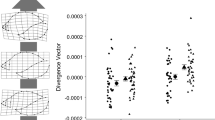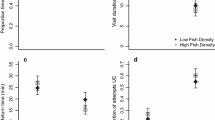Synopsis
The positive relationship between size of prey and frequency of ingestion by predators has been a focal point of investigations in foraging ecology. Field studies compare the frequency distribution of prey sizes in the predator's gut with that in the environment. Laboratory and field (enclosure) studies are based upon comparison of the frequency distributions of prey sizes in controlled environments, before and after the introduction of a predator. ‘Optimal’ caloric return for foraging effort (i.e. the theory of optimal foraging) has been widely used as a guiding principle in attempts to explain what a fish consumes. There is a body of information, however, which seems to indicate that the perceptual potentialities and cognitive abilities of a predator can account for both the direction of the prey size versus ingestion frequency relationship and the variance surrounding it. Part of this variance may be evidence of ‘systematic ambiguity’, a property of cognitive skills causing predators to respond to the same stimulus in different ways and to different stimuli in the same way. More extensive examination of cognitive skills (minimally defined as learning, remembering and forgetting) in fish may permit causal interpretations (immediate and ultimate) of variance in predatory skills. In such a paradigm of foraging behaviour, environmental stimulus is not taken as the predator's object of response (percept); a cognitive representation connects mind to stimulus and this is the criterion for the act of perception. Cognition, here considered as a formal system which acts upon representations, connects mind to response and thus to adaptation. Studies of the relationships among rates of learning, long and short-term memory, rates of forgetting, prey behavior, size and population turnover rates, lateralization of brain functions, diel fluctuations in predator activity levels and sleep, experience, and ‘critical periods’ in the development of the predator's nervous system should be examined in relation to foraging behaviour.
Similar content being viewed by others
References cited
Ahlbert, I.B. 1976. Organization of the cone cells in the retinae of salmon, Salmo salar and trout Salmo trutta in relation to their feeding habits. Acta Zool. 57: 13–35.
Ali, M.A. (ed.). 1975. Vision in fishes: a new approaches in research. Plenum Press, New York. 836 pp.
Bateson, W. 1889. Notes on the senses and habits of some crustacea. J. Mar. Biol. Assoc. UK 1: 211–224.
Blakemore, C. 1976. Modification of visual function by early visual experience. Bull. Schweiz. Akad. Med. Wiss. 32: 13–28.
Blakemore, C. 1977. Genetic instructions and developmental plasticity in the kitten's visual cortex. Phil. Trans. R. Soc. Lond. B 278: 425–434.
Blaxter, J.H.S. 1970. Sensory deprivation and sensory input in rearing experiments. Helgol. Wiss. Meeresunters. 20: 642–654.
Blaxter, J.H.S. 1975. Reared and wild fish. How do they compare? Proc. 10th Europ. Symp. Mar. Biol. 1: 11–26.
Brawn, V.M. 1969. Feeding behaviour of cod. J. Fish. Res. Board Can. 26: 583–596.
Broughton, R.J. 1975. Biorythm variations in consciousness and psychological functions. Can. Psychol. Rev. 16: 217–239.
Browman, H.I. 1985. Feeding behaviour in fry of Atlantic salmon, Salmo salar L. M.Sc. Thesis. McGill University, Montreal. 141 pp.
Browman, H.I. & B.M. Marcotte. 1986. Diurnal feeding and prey size selection in Atlantic salmon (Salmo salar L.) alevins. Dev. Env. Biol. Fish. 7: 269–284.
Bullock, T.H. 1983a. Why study fish brains? Some aims of comparative neurology today. pp. 361–368. In: R. E. Davis & R.G. Northcutt (ed.) Fish Neurobiology, Vol. 2, Higher Brain Areas and Functions, University of Michigan Press, Ann Arbor.
Bullock, T.H. 1983b. Neurobiological roots and neuroethological sprouts. pp. 403–412. In: F. Huber & H. Markl(ed.) Neuroethology and Behavioral Physiology, Springer-Verlag, New York.
Bullock, T.H. 1984a. Comparative neuroscience holds promise for quiet revolutions. Science 225: 473–478.
Bullock, T.H. 1984b. The future of comparative neurology. Amer. Zool. 24: 693–700.
Campbell, C.B.G. & W.W. Hodos. 1970. The concept of homology and the evolution of the nervous system. Brain Behav. Evol. 3: 353–367.
Cody, M.L. 1974. Optimization in ecology. Science 183: 1156–1164.
Cohen, J. 1969. Sensation and perception I. Vision. Rand McNally & Co., Chicago. 76 pp.
Cook, J.E. & T.J. Horder. 1977. The multiple factors determining retinotopic order in the growth of optic fibers into the optic tectum. Phil. Trans. R. Soc. Lond. B 278: 261–276.
Crick, F. & G. Mitchison. 1983. The function of dream sleep. Nature 304: 111–114.
Cronley-Dillon, J. R. 1964. Units sensitive to direction of movement in goldfish optic tectum. Nature 203: 214–215.
Diamond, J.M. 1984. Optimal foraging theory tested. Nature 311: 603–604.
Dickson, T.A. & H.R. MacCrimmon. 1982. Influence of hatchery experience on growth and behavior of juvenile Atlantic salmon (Salmo salar) within allopatric and sympatric stream populations. Can. J. Fish. Aquat. Sci. 39: 1453–1458.
Dill, L.M. 1983. Adaptive flexibility in the foraging behavior of fishes. Can. J. Fisher. Aquat. Sci. 40: 398–408.
Easter, S. S., P.R. Johns & L.R. Baumann. 1977. Growth of the adult goldfish eye I: optics. Vision Res. 17: 469–477.
Edelman, G.M. & L.H. Finkel. 1985. Neuronal group selection in the cerebral cortex. pp. 00–00. In: G.M. Edelman, W.M. Cowan & W.E. Gall (ed.) Dynamic Aspects of Neocortical Function, Wiley, New York (in press).
Fenderson, O.C., W.H. Everhart, & K.M. Muth. 1968. Comparative agonistic and feeding behavior of hatchery-reared and wild salmon in aquaria. J. Fish. Res. Board Can. 25: 1–14.
Fortier, L. 1983. Environmental and behavioral control of largescale distribution and local abundance of ichthyoplankton in the St. Lawrence estuary. Ph.D. Thesis, McGill University, Montreal. 176 pp.
Glasser, J.W. 1984. Is conventional foraging theory optimal? Amer. Nat. 124: 900–905.
Godin, J.-G.J. 1981. Daily patterns of feeding behaviour, daily rations, and diets of juvenile Pink salmon (Oncorhynchus gorbuscha) in two marine bays of British Columbia. Can. J. Fish. Aquatic Sci. 38: 10–15.
Hairston, N., T. Li Kao & S.S. Easter. 1982. Fish vision and the detection of planktonic prey. Science 218: 1240–1242.
Hubel, D.H. & T.N. Wiesel. 1970. The period of susceptibility to the physiological effects of unilateral eye closure in kittens. J. Physiol., London 206: 419–436.
Hunter, J.R. 1980. The feeding behavior and ecology of marine fish larvae. pp. 287–330. In: J.E. Bardach, J.J. Magnuson, R.C. May & J.M. Reinhart(ed.) Fish Behavior and Its Use In the Capture and Culture of Fishes, ICLARM, Manila.
Ingle, D. 1968. Spatial dimensions of vision in fish. pp. 51–59. In: D. Ingle(ed.) The Central Nervous System and Fish Behaviour, University of Chicago Press, Chicago. 272 pp.
Jacobson, M. & R.M. Gaze. 1964. Types of visual response from single units in the optic nerve of the goldfish. Quart. J. Expt. Physiol. 49: 199–209.
Johns, P.R. & S.S. Easter. 1977. Growth of the adult goldfish eye II: increase in retinal cell number. J. Comp. Neurol. 176: 331–342.
Karmanova, I.G., A.I. Belich & S.G. Lazarev. 1981. An electrophysiological study of wakefulness and sleep-like states in fish and amphibians. pp. 181–200. In: P.R. Laming(ed.) Brain Mechanisms of Behavior in Lower Vertebrates, Cambridge University Press, Cambridge.
Kaufman, L. & I. Rock. 1962. The moon illusion. Scient. Amer. 207: 120–130.
Keating, M.J. 1976. The formation of visual neuronal connections: an appraisal of the present status of the theory of neuronal plasticity. pp. 59–110. In: G. Gottlieb(ed.) Neuronal and Behavioral Specificity, Academic Press, New York.
Keating, M.J. 1977. Evidence for plasticity of intertectal neuronal connections in adult Xenopus. Phil Trans. R. Soc. Lond. B 278: 277–294.
Klein, R. & R. Armitage. 1979. Rhythms in human performance: 1 1/2 hour oscillations in cognitive style. Science 204: 1326–1328.
Kleitman, N. 1963. Sleep and wakefulness. Univ. Chicago Press, Chicago. 552 pp.
Kleitman, N. 1969. Basic rest-activity cycle in relation to sleep and wakefulness. pp. 33–38. In: A. Kales(ed.) Sleep Physiology and Pathology, Lippincott, Philadelphia.
Krebs, J.R. 1979. Foraging strategies and their social significance. pp. 225–270. In: P. Marler & J.G. Vandenbergh (ed.) Handbook of Behavioral Neurobiology, Vol. 3, Social Behavior and Communication, Plenum Press, New York.
Lasker, R. 1981. Marine fish larvae. Morphology, ecology, and relation to fisheries. University of Washington Press, Seattle. 131 pp.
Levins, R. 1975a. Evolution of communities near equilibrium. pp. 16–50. In: M.L. Cody & J.M. Diamond(ed.) Ecology and Evolution of Communities, Harvard University Press, Cambridge.
Levins, R. 1975b. The limits of optimization. pp. 49–60. In: Proceedings Can. Mathematical Congress, Mathematics in the Life Sciences.
Luecke, C. & W.J. O'Brien. 1981. Prey location volume of a planktivorous fish: a new measure of prey vulnerability. Can. J. Fish. Aquat. Sci. 38 1264–1270.
Luria, A.R. 1973. The working brain. Penguin, London. 398 pp.
MacCrimmon, H.R. 1954. Stream studies in planted Atlantic salmon. J. Fish. Res. Board Can. 11: 362–403.
Maiorana, V.C. 1981. Prey selection by sight: random or economical. Amer. Nat. 118: 450–451.
Marcotte, B.M. 1983. Imperatives of copepod diversity: perception, cognition, competition and predation. pp. 47–72. In: F. Schram(ed.) Crustacean Phylogeny, Balkema, Rotterdam.
McFarland, W.N. & E.R. Loew. 1983. Wave produced changes in underwater light and their relations to vision. Env. Biol. Fish. 8: 173–184.
Morgan, W.L. & D.A. Ritz. 1984. Effect of prey density and hunger state on capture of krill, Nyctiphanes australis S., by Australian salmon, Arripis trutta. J. Fish. Biol. 24: 51–58.
Neill, S.R. & J.M. Cullen. 1974. Experiments on whether schooling by their prey affects the hunting behavior of cephalopods and fish predators. J. Zool. Lond. 172: 549–569.
Northmore, D., F.C. Volkmann & D. Yager. 1978. Vision in fishes: colour and pattern. pp. 79–136. In: D.I. Mostofsky(ed.) The Behaviour of Fish and Other Aquatic Animals, Academic Press, New York.
O'Brien, W.J. 1979. The predator-prey interaction of planktivorous fish and zooplankton. Amer. Scient. 67: 572–581.
Oliphan, V.I. 1957. On the diel rhythm of feeding among Baikal grayling fry, and on diel rhythms among young fish in general. Doklady Akademii Nauk (USSR) 114: 669–672.
Peeke, H.V., S.C. Peeke & J.S. Williston. 1972. Long term memory deficits for habituation of predatory behavior in the forebrain ablated goldfish (Carassius auratus). Exp. Neurol. 36: 288–294.
Pinskii, F. Ya. 1967. Daily feeding rhythm and diets of young of the salmon (Salmo salar L.) when raised in ponds. Fish. Res. Board. Can. Translation Ser. No. 114.
Pyke, G.H., H.R. Pulliam & E.L. Charnov. 1977. Optimal foraging: a selective review of theory and tests. Quart. Rev. Biol. 52: 137–154.
Ringler, N.H. 1983. Variation in foraging tactics of fishes. pp. 159–171. In: D.L.G. Noakes et al. (ed.) Predators and Prey in Fishes, Dev. in Env. Biol. Fish. 2, Dr W. Junk Publishers, The Hague.
Ross, J., B. Jenkins & J.R. Johnstone. 1980. Size constancy fails below half a degree. Nature 283: 473–474.
Schoener, T.W. 1979. Generality of the size-distance relation in models of optimal foraging. Amer. Nat. 114: 902–914.
Shustov, Yu.A., I.L. Shchurov & Yu.A. Smirnov. 1980. Adaptation times of hatchery salmon, Salmo salar, to river conditions. J. Ichthyol. 20: 156–159.
Sosiak, A. J., R.G. Randall & J.A. McKenzie. 1979. Feeding by hatchery-reared and wild Atlantic salmon (Salmo salar) part in streams. J. Fis. Res. Board Can. 36: 1408–1412.
Sutherland, N.S. 1968. Shape discrimination in the goldfish. pp. 33–50. In: D. Ingle(ed.) The Central Nervous System and Fish Behaviour, University of Chicago Press, Chicago.
Thorpe, W.H. 1969. Learning and instinct in animals. Harvard University Press, Cambridge. 558 pp.
Trevarthen, C. 1968. Vision in fish: the origins of the visual frame of action in vertebrates. pp. 61–94. In: D. Ingle(ed.) The Central Nervous System and Fish Behaviour, University of Chicago Press, Chicago.
Vinyard, G.I. & W.J. O'Brien. 1976. Effects of light and turbidity on the reactive distance of Bluegill sunfish (Lepomis machrochirus). J. Fish. Res. Board Can. 33: 2845–2849.
Ware, D.M. 1971. Predation by rainbow trout (Salmo gairdneri): the effect of experience. J. Fish. Res. Board Can. 28: 1842–1852.
Werner, R.G. & J.H.S. Blaxter. 1980. Growth and survival of larval herring (Clupea harengus) in relation to prey density. Can. J. Fish. Aquat. Sci. 37: 1063–1069.
Williams, G.C. 1964. Measurement of co-association among fishes and comments on the evolution of schooling. Publ. Mus. Michigan State Univ. 2: 351–383.
Author information
Authors and Affiliations
Rights and permissions
About this article
Cite this article
Marcotte, B.M., Browman, H.I. Foraging behaviour in fishes: perspectives on variance. Environ Biol Fish 16, 25–33 (1986). https://doi.org/10.1007/BF00005157
Received:
Accepted:
Issue Date:
DOI: https://doi.org/10.1007/BF00005157




